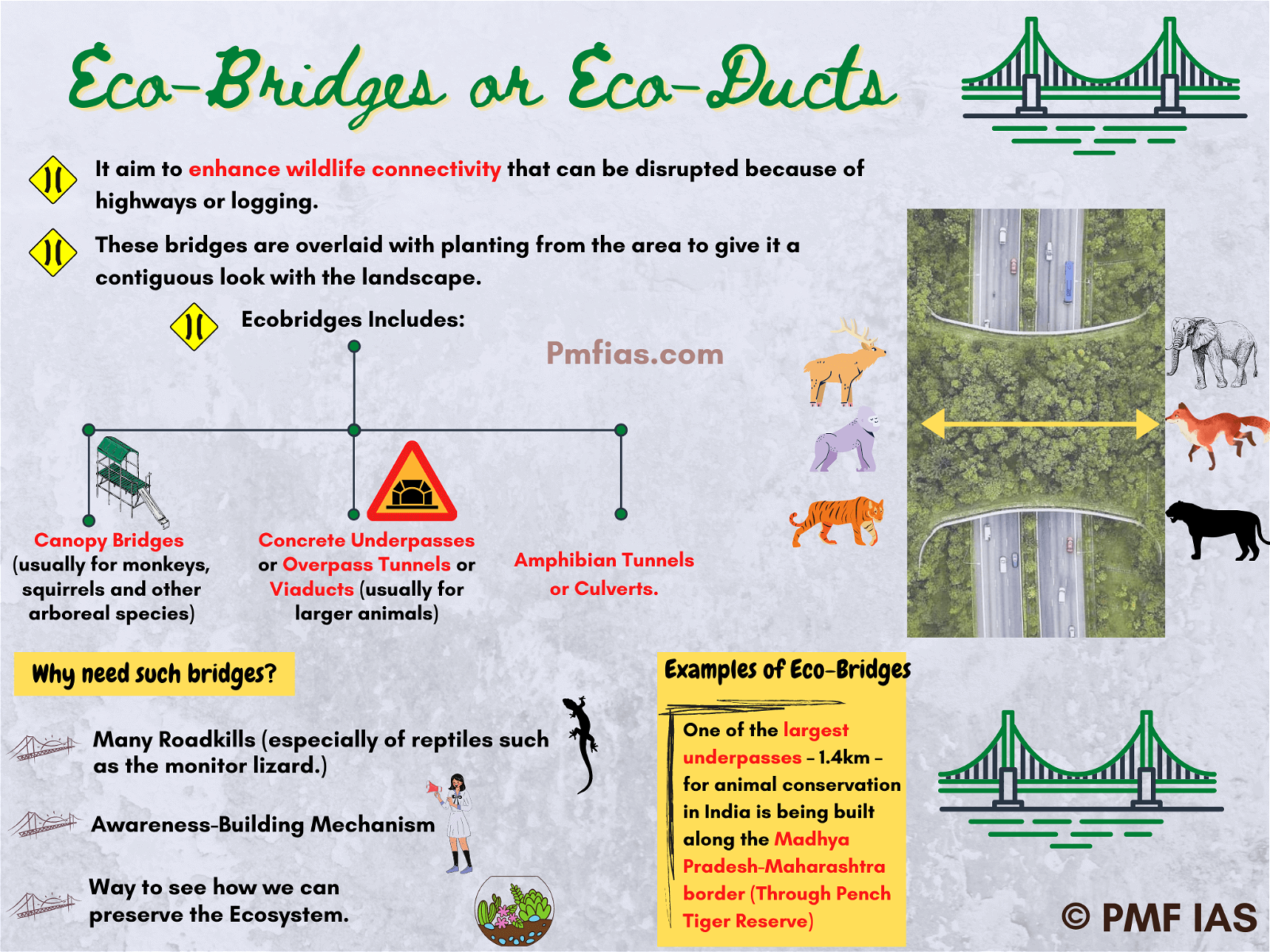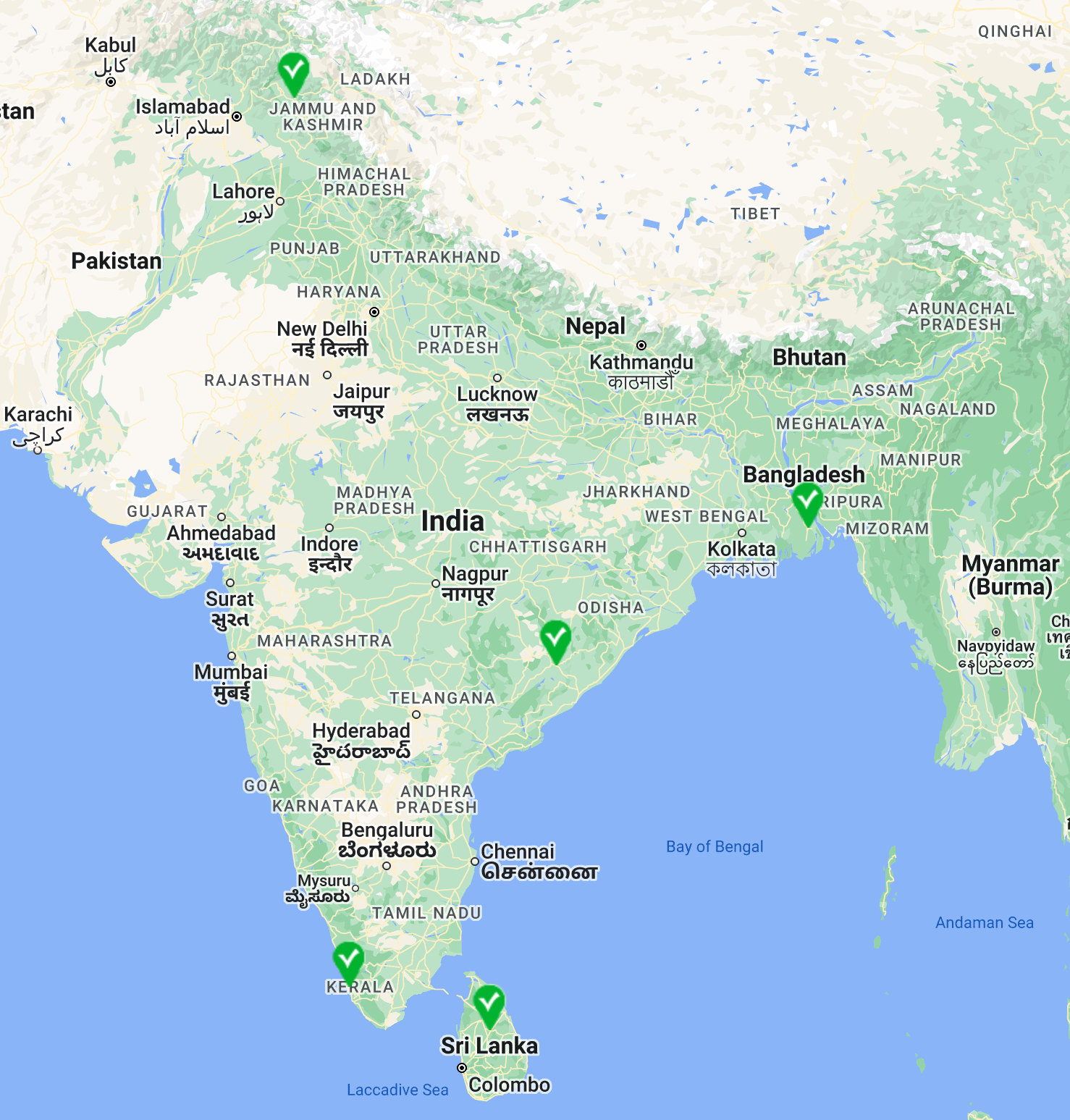
Eco-bridges or Eco-ducts for Sustainable development
Subscribe to Never Miss an Important Update! Assured Discounts on New Products!
Must Join PMF IAS Telegram Channel & PMF IAS History Telegram Channel
Last updated on April 25, 2024 6:45 PM
What are Eco-bridges or Eco-ducts?
- Eco-bridges aim to enhance wildlife connectivity, that can be disrupted because of highways or logging.
- Eco-bridges include
- canopy bridges (usually for monkeys, squirrels & other arboreal species);
- concrete underpasses or overpass tunnels or viaducts (usually for larger animals); &
- amphibian tunnels or culverts.
- Usually, these bridges are overlaid with planting to give it a contiguous look with the landscape.

Environment vs. Development
- In most of the cases, it is not possible to complete development projects without harming the environment.
- The scenario is grave in India as it does not have enough resources to balance environment & development.
- Projects must be completed either with high environmental costs or high financial costs.
- With a complex web of legal processes (SC, NGT) & regulatory regimes (NTCA, National Board for Wildlife, etc), the development projects are stalled midway & the project costs skyrocket over the years.
Case 1
- In June 2019, SC ordered to halt the construction of a road that passes through the “critical” corridor between the Rajaji & Corbett Tiger Reserves as it violates numerous provisions of the Forest Conservation Act.
- The road is being built without the statutory approval of the National Board for Wildlife.
- The advice of the National Tiger Conservation Authority (NTCA) has also not been taken.
Case 2
- NHAI’s project to widen NH 44 through Pench Tiger Reserve is mired in legal hurdles.
- The NH 44 stretch passes through the eco-sensitive zone of Pench Tiger Reserve (PTR) on both Maharashtra & Madhya Pradesh sides.
- In 2008, Wildlife Trust of India (NGO) had moved SC seeking a ban on NHAI’s project.
- NHAI’s project would involve felling more than 22,000 trees in the critical corridor.
- According to NTCA & Wildlife Institute of India (WII), the forest connecting Kanha & Pench TRs is one of the four most viable tiger habitats (the other three being the Western Ghats, Corbett & Kaziranga).
- NHAI made several changes in the plan to address the concerns raised by wildlife experts.
- GOI is now spending a whooping ₹1300 crore to build 9 km of highway with 13 underpasses in Pench TR.
- Demands have been raised to build such underpasses on the NH between Mysuru & Wayanad to protect tigers in the Bandipur wildlife sanctuary.
The Effect on the tiger population
- Central India’s tigers have the highest genetic variation among Indian tigers.
- This has been made possible by the large habitats available here in the past.
- When populations are isolated by linear projects, there’s the risk of inbreeding of disease & local extinction.
Eco-bridges for Sustainable development (balancing development and environment)
- Nine ‘animal underpasses (viaducts)’ were built in 2018 beneath a stretch of NH 44 (Srinagar to Kanyakumari — India’s longest highway) between Kanha & Pench tiger reserves.
- GOI will construct a 36 km-long flyover above NH 37, which passes through the Kaziranga National Park.
- These viaducts prevent roadkill & reduce the ‘barrier effect’ that roads have on the movement of animals.
- These underpasses are examples of ‘wildlife mitigation measures’ or attempts to remedy the impact of infrastructure on wild animals (attempting for sustainable development).
- According to an estimate, around 55,000 km of roads pass through India’s forests & protected areas.
- NH 44 cuts through corridors connecting Kanha, Satpura, Pench, Bandhavgarh, Panna tiger reserves.
- NH 6 — India’s second longest highway that runs from Surat to Kolkata — passes through corridors around Melghat, Bor, Nagzira, Simlipal tiger reserves.
Tiger Reserves Map: https://drive.google.com/file/d/1kA-_Rn32zbn8XvhGo9rA7u3JGMA_buYp/view
Prelims PractiseConsider the following statements
Which of the above statement(s) are false?
Explanation
Answer: NoneConsider the following
Which of the above are statutory bodies?
Explanation
Answer: 2, 3, 4 & 5 only (d)Consider the followingWhich of the above are NGOs?
Explanation
Answer: one and three only (c) |
Summary
- Eco-bridges aim to enhance wildlife connectivity, that can be disrupted because of highways or logging.
- They include canopy bridges, underpasses or overpasses or viaducts & amphibian tunnels or culverts.
- In 2008, Wildlife Trust of India (NGO) had moved SC seeking a ban on the widening of NH44.
- The NH 44 stretch passes through the eco-sensitive zone of Pench Tiger Reserve.
- NH 44 cuts through corridors connecting Kanha, Satpura, Pench, Bandhavgarh, Panna tiger reserves.
- The forest connecting Kanha & Pench TRs is one of the four most viable tiger habitats (the other three being the Western Ghats, Corbett & Kaziranga).
- GOI is now spending a whooping ₹1300 crore to build 9 km of highway with 13 viaducts in Pench TR.
- These viaducts prevent roadkill & reduce the ‘barrier effect’ that roads have on the movement of animals.
- These underpasses are examples of wildlife mitigation measures.
Last updated on April 25, 2024 6:45 PM











